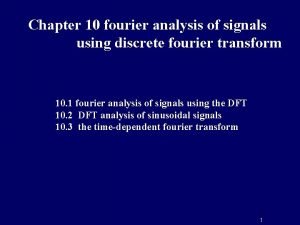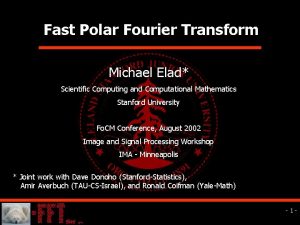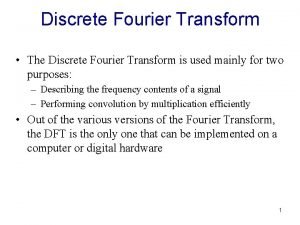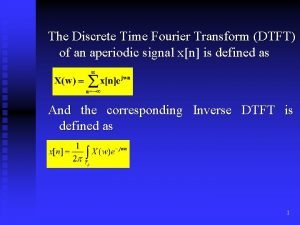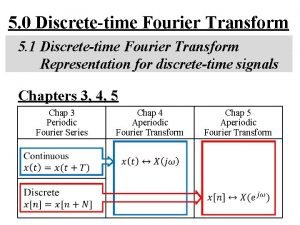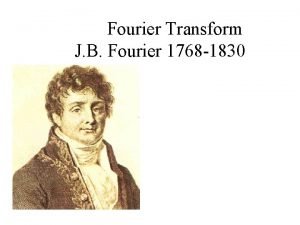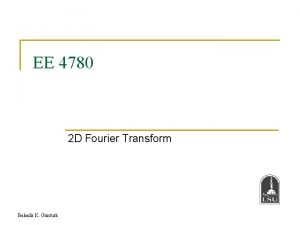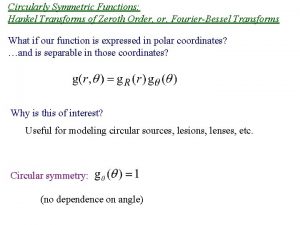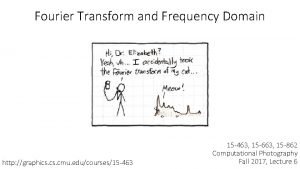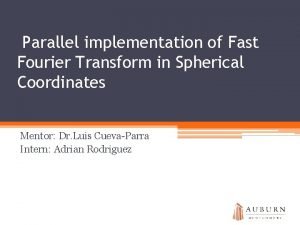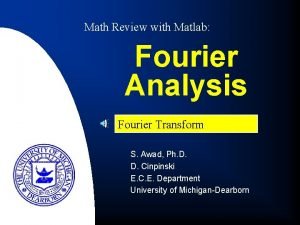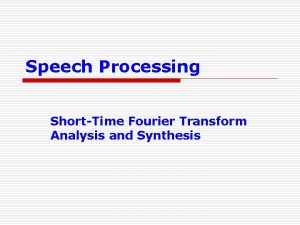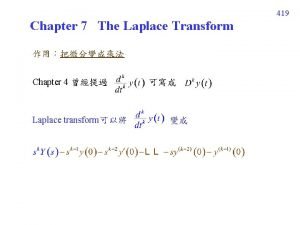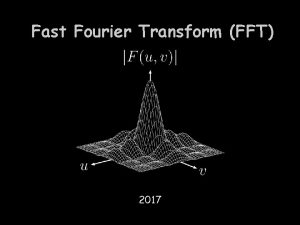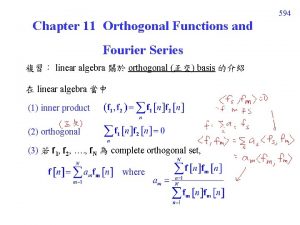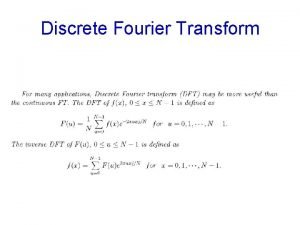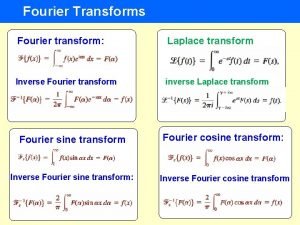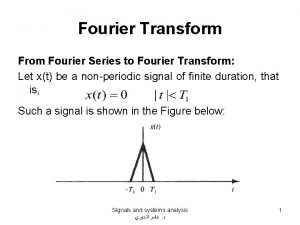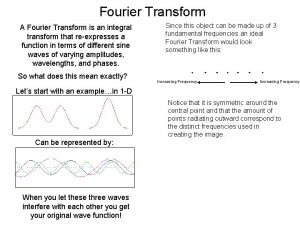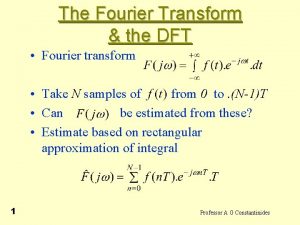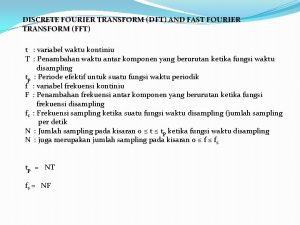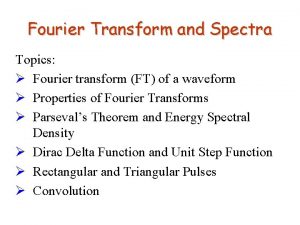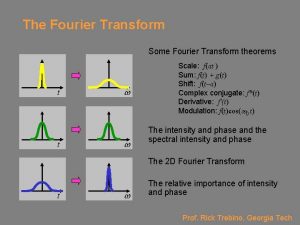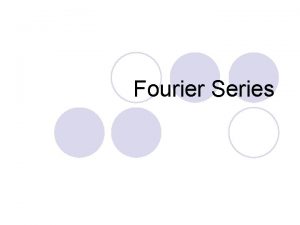The Fourier Transform What is the Fourier transform

























![The Fourier transform of a double pulse f(t) = rect[(t+a)/w] + rect[(t-a)/w] Use the The Fourier transform of a double pulse f(t) = rect[(t+a)/w] + rect[(t-a)/w] Use the](https://slidetodoc.com/presentation_image_h/9299955f96551dd1d7ad27a3c35ef086/image-26.jpg)





- Slides: 31

The Fourier Transform What is the Fourier transform? Fourier cosine and sine series for even and odd functions The continuous limit: the Fourier transform (and its inverse) F(w) f(t) Some transform examples and theorems The Uncertainty Principle t w 0 The Fourier transform with respect to position and the 2 D Fourier transform Prof. Rick Trebino, Georgia Tech, www. frog. gatech. edu

What do we hope to achieve with the Fourier transform? Plane waves have only one frequency, w 0. Light electric field We desire a measure of the frequencies present in a wave. This will lead to a definition of the spectrum. Time This light wave has many frequencies. And the frequency increases in time (from red to blue).

Many waves are sums of sinusoids. Sine wave #2 Time Sine wave #1 Consider the sum of two sine waves of different frequencies: Sum The spectrum of the sum of the two sine waves: This is a common situation, especially when boundary conditions are present. Frequency #1 Frequency #2 Frequency

Joseph Fourier brought the Rosetta stone back from Egypt when he accompanied Napoleon there, and he discovered the greenhouse effect of the earth’s atmosphere. Joseph Fourier (1768 – 1830) Fourier was obsessed with the physics of heat and developed the Fourier series and transform to model heat-flow problems.

Lord Kelvin on Fourier’s theorem “Fourier’s theorem is not only one of the most beautiful results of modern analysis, but it may be said to furnish an indispensable instrument in the treatment of nearly every recondite question in modern physics. ” Lord Kelvin

Fourier decomposing functions Here, we write a square wave as a sum of sine waves of different frequencies.

Any function can be written as the sum of an even and an odd function.

Fourier cosine series Because cos(mt) is an even function (for all m), we can write an even function, f(t), as: where the set {Fm; m = 0, 1, … } is a set of coefficients that define the series. And where we’ll only worry about f(t) over the interval (–p, p).

Finding the coefficients Fm in a Fourier cosine series To find Fm: Multiply each side by cos(m’t), where m’ is another integer, and integrate: But: So: Dropping the ’ from the m: only the m = m’ term contributes yields the coefficients for any even f(t)!

Fourier sine series Because sin(mt) is an odd function (for all m), we can write any odd function, f(t), as: where the set {Fm’; m = 0, 1, … } is a set of coefficients that define the series. where we’ll only worry about the function f(t) over the interval (–p, p).

Finding the coefficients Fm’ in a Fourier sine series To find F’m : Multiply each side by sin(m’t), where m’ is another integer, and integrate: But: So: Dropping the ’ from the m: only the m = m’ term contributes yields the coefficients for any odd f(t)!

Fourier series If f(t) is a general function, neither even nor odd, it can be written: even component odd component where and

We can plot the coefficients of a Fourier series. 1 Fm vs. m Let the integer m become a real number and let the coefficients Fm become a function F(m) 0 10 20 30 m We really need two such plots, one for the cosine series and another for the sine series.

The Fourier transform Let’s define a function F(m) that incorporates both cosine and sine series coefficients, with the sine series distinguished by making it the imaginary component: F(m) º Fm – i Fm’ = Now allow f(t) to range from –¥ to ¥, so we’ll have to integrate from –¥ to ¥, and redefine m to be the frequency, which we’ll now call w: The Fourier Transform F(w) is called the Fourier Transform of f(t). It contains equivalent information to that in f(t). We say that f(t) lives in the time domain, and F(w) lives in the frequency domain. F(w) is just another way of looking at a function or wave.

The inverse Fourier transform The Fourier Transform takes us from f(t) to F(w). How about going back? Recall our formula for the Fourier Series of f(t): Now transform the sums to integrals from –¥ to ¥, and again replace Fm with F(w). And remembering the factor of i (and including a factor of ½ to account for double summing in integrating from –¥ to ¥, rather than 0 to ¥), we have: Inverse Fourier Transform

The Fourier transform and its inverse The Fourier Transform and its Inverse: Fourier Transform Inverse Fourier Transform So we can transform to the frequency domain and back. Interestingly, these transformations are very similar. These equations together are Fourier’s Theorem. Feel free to plug one into the other to verify that you get the function you started with!

Fourier transform notation There are several ways to denote the Fourier transform of a function. If the function is labeled by a lower-case letter, such as f, we can write: f(t) ® F(w) If the function is already labeled by an upper-case letter, such as E, we can write: or: ∩ Sometimes, this symbol is used instead of the arrow:

The spectrum We define the spectrum, S(w), of a wave E(t) to be: This is the measure of the frequencies present in a wave. What about the phase (j) of the Fourier transform—called the spectral phase—which we lose when we take its squared magnitude? It yields the absolute phase of a given frequency’s sine wave (at t = 0), which yields information about when a particular frequency occurs (by computing dj/dw).

Example: the Fourier transform of a rectangle function, rect(t) 1 -. 5 0 rect(t). 5 t sinc(w/2) zeros at w = 2 np (n ≠ 0) The sinc function is important in many fields. w

The Fourier transform of a Gaussian is a Gaussian! Fourier transforms can be difficult to do. But here’s an important one you can try on your own if you like. f(t) = exp(-t 2/2) t w f(t) and F(w) look similar, but remember that these functions live in different spaces or domains (that is, have different arguments)!

Scale Theorem The Fourier transform of a scaled function, f(at): Proof: Assuming a > 0, change variables: u = at, so t = u/a and dt = du/a If a < 0, the limits flip when we change variables, introducing a minus sign, hence the absolute value. Q. E. D.

F(w) f(t) The Scale Theorem in action The shorter the pulse, the broader the spectrum! This is the essence of the Uncertainty Principle! Short pulse t w t w Mediumlength pulse Long pulse

The pulse width Dt There are many definitions of the width or length of a wave or pulse. t The effective width is the width of a rectangle whose height and area are the same as those of the pulse. Effective width ≡ Area / height: f(0) Dteff 0 t We can similarly define widths of F(w), the spectrum, or any other quantity.

The Uncertainty Principle says that the product of a function's widths in the time domain (Dt) and the frequency domain (Dw) is ≥ ~1. Use effective widths assuming f(t) and F(w) peak at 0: 1 1 Dn Dt = Time-Bandwidth Product Combining results: or: Different width definitions yield different numbers (e. g. , Dw Dt ≥ ½).

Shift Theorem The Fourier transform of a shifted function, f(t-a). Proof: Change variables: u = t - a, so t = u + a and dt = du: Q. E. D.
![The Fourier transform of a double pulse ft recttaw recttaw Use the The Fourier transform of a double pulse f(t) = rect[(t+a)/w] + rect[(t-a)/w] Use the](https://slidetodoc.com/presentation_image_h/9299955f96551dd1d7ad27a3c35ef086/image-26.jpg)
The Fourier transform of a double pulse f(t) = rect[(t+a)/w] + rect[(t-a)/w] Use the scale and shift theorems simultaneously: w -a w 0 a t F(w) sinc(ww/2) w Simplifying:

Spectra of single and double pulses Single pulse w Double pulse w Rectangular pulses

The Fourier transform of a pulsed wave Because the Fourier transform and inverse Fourier transform are so similar, any theorem for one also holds for the other, subject to a change in minus sign (and perhaps a factor of 2 p). Taking the Fourier transform of both sides: Often called the Modulation Theorem This means that shifting the frequency of a wave moves its spectrum: F(w) f(t) t w 0

Fourier Transform with respect to space If f(x) is a function of position, f(x) x F {f(x)} = F(k) We refer to k as the spatial frequency. F(k) k Everything we’ve said about Fourier transforms between the t and w domains also applies to the x and k domains.

The 2 D Fourier Transform Suppose we have a function of x and y. Then: F = (2){f(x, y)} f(x, y) = F(kx, ky) x f(x, y) exp[-i(kxx+kyy)] dx dy If f(x, y) = fx(x) fy(y), then the 2 D FT splits into two 1 D FT's. But this doesn’t always happen. F y (2){f(x, y)}

A 2 D Fourier Transform: a square function f(x, y) Consider a 2 D rectangular function in the xy plane: f(x, y) = rect(x) rect(y) x Its 2 D Fourier transform splits into the product of two 1 D Fourier transforms: F |F {f(x, y)} = sinc(kx/2) sinc(ky/2) This picture is an optical determination of the mag-squared Fourier transform of the 2 D rectangular function! ky kx y (2){f(x, y)}|2
 Fourier transform conclusion
Fourier transform conclusion Polar fft
Polar fft Fourier transform equations
Fourier transform equations Fourier transform of reciprocal function
Fourier transform of reciprocal function The fourier transform of unit impulse function is
The fourier transform of unit impulse function is What is dft
What is dft Jpeg fourier transform
Jpeg fourier transform Rect(t-1/2)
Rect(t-1/2) Fourier transform solver
Fourier transform solver Discrete time fourier transform
Discrete time fourier transform Duality of fourier transform
Duality of fourier transform Fourier transform
Fourier transform Fourier series multiplication property
Fourier series multiplication property Circ function fourier transform
Circ function fourier transform Fourier transform in computer vision
Fourier transform in computer vision Fourier transform formula
Fourier transform formula Application of discrete fourier transform
Application of discrete fourier transform Fourier transform spherical coordinates
Fourier transform spherical coordinates Matlab ramp function
Matlab ramp function Fourier transform
Fourier transform Aperiodic signal
Aperiodic signal Short time fourier transform applications
Short time fourier transform applications Continuous fourier transform formula
Continuous fourier transform formula Laplace integral transform
Laplace integral transform Parseval's identity
Parseval's identity Fast fourier transform
Fast fourier transform Fourier transform of product of two functions
Fourier transform of product of two functions Orthogonal functions in fourier series
Orthogonal functions in fourier series Fourier transform convolution
Fourier transform convolution Inverse of fourier transform
Inverse of fourier transform Fourier transform gaussian
Fourier transform gaussian 2d discrete fourier transform
2d discrete fourier transform
